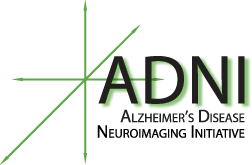MRI data is one component of the comprehensive data set collected in ADNI participants. ADNI began in 2004 and to date 3 different phases of ADNI have been undertaken. The MR protocol evolved over these 3 phases. The MRI protocol for ADNI1 (2004-2009) focused on consistent longitudinal structural imaging on 1.5T scanners using T1- and dual echoT2-weighted sequences. One-fourth of ADNI 1 subjects were also scanned using essentially the same protocol on 3T scanners.
In ADNI-GO/ADNI2 (2010-2016), imaging was performed at 3T with T1-weighted imaging parameters similar to ADNI1. In place of the dual echo T2-weighted image from ADNI1, 2D FLAIR and T2*-weighted imaging was added at all sites. Both fully sampled and accelerated T1-weighted images were acquired in each imaging session. Advanced imaging was included depending on scanner manufacturer: diffusion imaging on GE scanners, resting state functional MRI on Philips scanners and arterial spin labeling on Siemens scanners.
ADNI 3 imaging is being done exclusively on 3T scanners. Nearly all of the imaging sequences from ADNI2 have been updated for inclusion in ADNI 3. Each of the ADNI 2 advanced imaging sequences is now included in the basic ADNI 3 protocol with a few site-wise exceptions related to sequence license issues.
In order to create imaging protocols that can be used to support drug studies, it is necessary to restrict the sequences employed to those commercially available on scanners.
ADNI users should be aware that there is a broad gap between older MRI systems and the state-of-the-art systems within each vendor’s product line. Thus, the ADNI MR data set includes a wide range of scanner platforms. A two-tiered approach is taken to accommodate the range of variability in scanners in ADNI 3. ‘ADNI 3 Basic’ and ‘ADNI 3 Advanced’ protocols have been created.
Both images and quantitative numeric ADNI MR data are available publically. All scans remain available for download by qualified users and are accessible via the Image Data Archive. The types of scans collected from each phase of the study are listed below. To view a full list of study data, review the data inventory page.
| ADNI1 (1.5T Scanner) |
ADNI GO/2 (3T Scanner) |
ADNI 3 |
Participant Scan:
|
Participant Scan:
|
Participant Scan:
|
Phantom Scan:
|
Phantom Scan:
|
Phantom Scan:
|
Quality Control
Each series in each exam undergoes quality control at Mayo Clinic. Two levels of quality control are performed; adherence to the protocol parameters and series-specific quality (i.e., subject motion, anatomic coverage, etc.). Scan quality is graded subjectively by trained analysts: 1-3 is acceptable and 4 is failure (unusable). This QC information will eventually be available for each series on LONI. Thus, users will be able to easily employ exam level QC information as filters in data collections.
SCANNER CHANGES
MR scanners routinely undergo upgrades. These can be relatively minor (SW version) or major (hardware changes, e.g. head coil). In some cases, the scanner itself will be replaced at an ADNI site. We advise the following approach to the issue of scanner changes:
- Assume that longitudinal within subject data is not compatible before vs after a change in scanner.
- Assume that longitudinal within subject data is not compatible before vs after a major hardware change e.g., change in head coil.
- Assume that longitudinal within subject data maybe compatible before vs after a SW version change, but be advised that this may not be shown to be true eventually for some types of SW changes.
All technical scanner information is available in the DICOM headers, however this is not easily searchable at present (January 2018). Eventually, the relevant technical scanner information will be easily available and downloadable at the exam level for ADNI users at the time they create either image or numeric data collections. Thus users will be able to easily employ exam level technical scanner information as filters in data collections.
ADNI 2 TO 3 PROTOCOL COMPATIBILTY
Our approach to developing the ADNI 3 protocol was that the ADNI 3 protocol had to be modernized even if this introduced non-compatibility between ADNI 2 and ADNI 3 data for some series. Details are noted in the Series Types chart.
|
3D T1 |
Spatial resolution was improved slightly in ADNI 3 to 1mm cubed. We believe this should not have a dramatic effect on longitudinal within person analyses. |
|
FLAIR |
Changed from 2D to 3D in ADNI 3. This introduces a significant improvement in spatial resolution plus a change in the contrast model. It is doubtful that this data type will be consistent from ADNI 2 to ADNI 3 without significant data processing to account for the change in acquisition. |
|
T2* GRE |
No change from ADNI 2 to ADNI 3 for GE or Philips scanners. A 3-echo train GRE sequence is acquired on Siemens scanners with phase and magnitude volumes saved for each echo. This will allow creation of pseudo quantitative susceptibility maps. The magnitude 20ms volume (3rd echo), from these Siemens GRE acquisitions, is compatible with GRE scans acquired in ADNI GO/2. |
|
Hi resolution coronal for hippocampal subfields little change, should be compatible from ADNI 2 to ADNI 3 |
|
|
ASL |
2D PASL was used in ADNI 2 and 3D (PASL or pCASL) are used wherever possible in ADNI 3. Thus this data t ype is unlikely to be compatible between ADNI 2 and ADNI 3. |
|
DTI |
ADNI 3 uses 2.0 mm isotropic voxels, but ADNI 2 used 2.7 mm, with b = 0 and 1000 s/mm2 weighted volumes. ADNI3 Basic and Advanced both provide b = 0 and 1000 s/mm2 weighted volumes, but the b = 500 and 2000 s/mm2 volumes of Advanced would have to be excluded before comparison with ADNI 2. |
|
fMRI |
The basic version of each of these should be fairly compatible, but the advanced ADNI 3 version will not be compatible with ADNI 2 data |
Recommended Image Data: Which scan to select?
For researchers interested in the imaging process as a whole, imaging files are available at every stage of pre- and post-processing. However, most researchers will prefer to use the scans that have undergone the maximum level of correction. These MPRAGE files are considered the best in the quality ratings and have undergone gradwarping, intensity correction, and have been scaled for gradient drift using the phantom data.


